CLIMATE CHANGE CONCEPT MAP
af Julian Jaramillo


1. solar power from the sun that's converted into energy and is a clean, renewable resource
2. ocean currents
2.1. Continuous, predictable, directional movement of seawater driven by gravity, water density, and the coriolis effect.
3. sea levels rising
3.1. as there is added water from ice sheets melting
3.2. warmer water from the increase in temperature expands
4. climate
4.1. long lasting weather conditions in a specific area
5. weather
5.1. the conditions of a specific area within a one day period.
6. polar ice caps
6.1. high latitude miniature ice sheets that cover underlying land features
7. atmospheric circulation
7.1. Large-scale movement of air by which heat is distributed on the surface of the Earth
8. loss of snowpack
8.1. the lessening of snowfall that's essential to supply our reservoirs
9. water supply
9.1. the supplying of water for a community through a reservoir, tunnel, or pipeline
10. hurricanes
10.1. A type of storm that is called a tropical cyclone that forms over tropical waters.
11. the warming of the Earth lessens the snowpack which supplies us with less water supply in our reservoirs
12. carbon emission
12.1. carbon dioxide released into the atmosphere, harmful to enviorment
13. the heating of Earth's climate system mainly due to human activity since the industrial period; the burning of fossil fuels traps carbon dioxide causing temperatures to rise
14. the recycle process of carbon dioxide and how it is a recurring cycle that travels through many organisms but eventually ends up in the atmosphere
15. without the heating of the greenhouse effect the Earth's average temperature would only be -18 Celsius; the sun's light shines on the surface and then gets trapped
16. migration
16.1. change in their natural habitats has caused many marine species to relocate
17. carbon cycle
18. deforestation
18.1. cutting down trees releases all the stored carbon dioxide from photosynthesis back into the atmosphere
18.2. as less trees remain to absorb the carbon dioxide oceans are left to do so
19. carbon dioxide
19.1. One carbon compound and 2 oxygen atoms
19.2. catches infrared radiation
20. greenhouse gases
20.1. made up of three or more atoms
20.2. absorb long wave radiation from the atmosphere
21. fossil fuels
21.1. organic organisms that are formed from plant and animal remnants
21.1.1. coal
21.1.2. oil
21.1.3. natural gas (methane)
